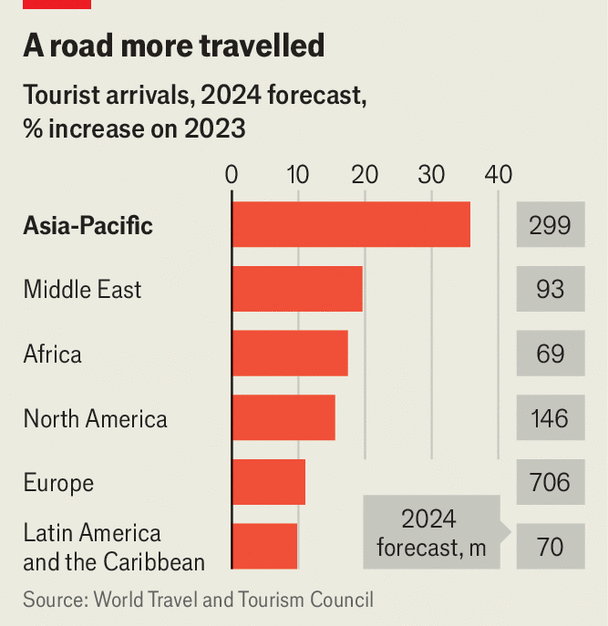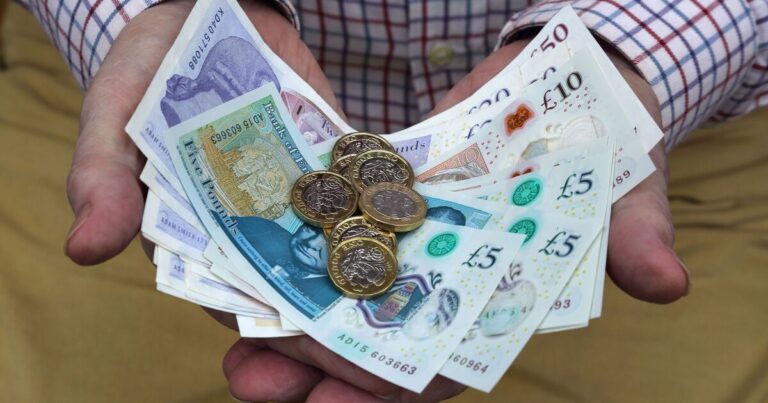Tourism is back, at last. This year the number of trips abroad is expected to overtake levels reached in 2019. Spending by travellers, too, is projected to exceed what was shelled out in 2019, according to the World Travel and Tourism Council (wttc), a trade body. Cruising is afloat again. The return of mass tourism has sparked protests in Western hotspots such as Barcelona and Majorca. Talk to a hotelier or a travel agent, though, and the real action is further east.

Travel to Asia had been slower to recover from the covid-19 pandemic than in the West. Strict quarantine measures from China to Malaysia were in place for longer than in Europe or America, keeping the number of tourists down. Now, however, business on the continent is roaring back. The number of travellers arriving in Asian countries is set to surge by a third this year, according to the WTTC, more than in any other region (see chart).
Even as business in the rest of the world stabilises, industry bosses are touting rapid growth in Asia. On August 6th Michael Glover, the finance chief of IHG, a hotel group, pointed to its booming business in Thailand and Vietnam. On August 7th Mark Galardo, an executive at Air Canada, a carrier, said that new routes to Seoul and Osaka were performing “exceedingly well”.
Westerners are turning up in droves. The number of trips Americans took to Asia doubled last year. The dollar, which has appreciated strongly against Asian currencies, is part of the explanation. Catherine Heald, the boss of Remote Lands, a travel agency for the rich, notes that more of her clients are scuba diving off Indonesia’s Komodo island, temple-hopping in Japan and taking gastronomical excursions across Thailand.
The range of destinations and activities is widening. Well-heeled tourists can travel aboard the recently redeveloped Eastern & Oriental Express through Singapore and Malaysia, run by Belmond, the hotels business of LVMH, a French luxury giant. Over 500,000 hotel rooms were under construction across Asia as of June, up by over 4% from last year. Getting to Asia is also becoming easier, with home-grown and Western airlines increasing the number of flights to and from the continent. British Airways, for instance, is relaunching flights to Bangkok and Kuala Lumpur.
The biggest boost to Asian tourism, though, is coming from the region’s own travellers. Chinese consumers have begun to holiday abroad again, with international trips forecast to double this year compared with 2023, according to Oxford Economics, a research firm. Even then, the number of trips will be below pre-pandemic levels, leaving plenty of room for growth. Much of the travel by Chinese tourists will happen within their neighbourhood. Three-quarters of the flights that left China last month went to East and South-East Asia.
Thanks to rising disposable incomes, India’s consumers are also heading overseas in growing numbers. They spent close to $20bn on foreign trips in the year to March, more than three times the amount they spent five years ago. Many also prefer to travel closer to home, not least because of looser visa restrictions in the region. As incomes rise, Indian tourists will only become bigger spenders. The WTTC reckons that by the end of the decade only Americans and Chinese will splurge more on overseas travel than Indians. Asia’s travel boom is just beginning. ■
To stay on top of the biggest stories in business and technology, sign up to the Bottom Line, our weekly subscriber-only newsletter.



















